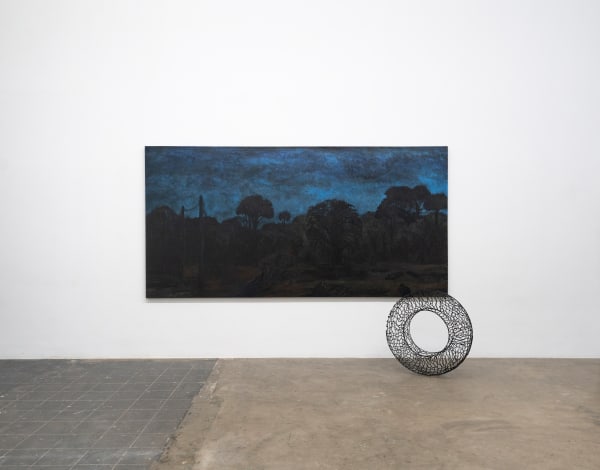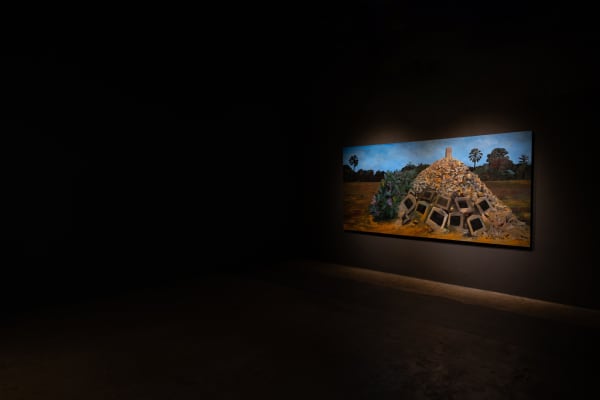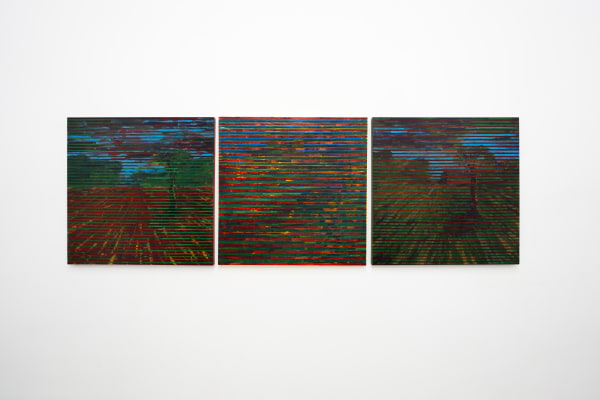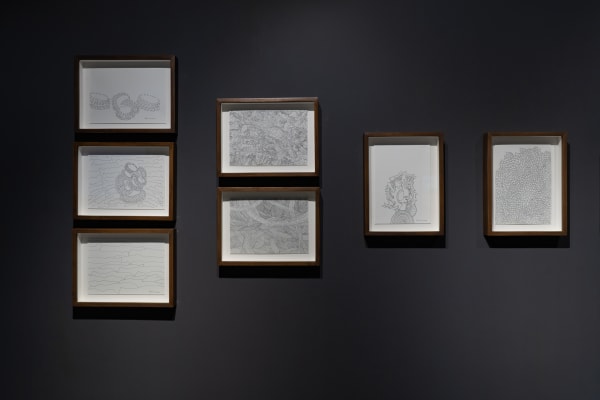META-REAL: Chandraguptha Thenuwara
The exhibition title Meta-Real is a constructed word that uses the prefix 'Meta' with the adjective 'Real'. Meta is a prefix from the ancient Greek word "beyond'. The definition of the adjective ‘real’ is 1. existing as a thing or occurring in fact; not imagined or supposed. 2. (of a thing) not imitation or artificial; genuine. In philosophy, 'real' is defined as the essence, or nature, of the entity in question, that which makes the entity the very thing it is rather than something else.
The exhibition Meta-Real invites viewers to see beyond the so-called real and question what they see, especially this year, given that the elections have been declared. Amazing things are happening. Illusionary promises are being made. Politicians who have previously been revolutionary reinterpreting the past according to temporary political needs of the present.
We are living in a country where an uprising Áragalaya took place recently. We are still experiencing the effects of financial and political bankruptcy and continuing in our struggle to get out of it. We experienced three decades of war since 1983. In 2009, over 15 years ago, the war was ended militarily. Death, disappearances, disability, and displacement experienced in the war years still matter. Terrorism, terror, threats, destruction, arson, abuse and misuse of power, corruption, malpractices, nationalism, extremism, ethnocentrism, racism, hate, misinterpretations, constructed lies, moral policing, thugs and drugs, etc. are part of everyday life. This is mixed with a 'political and historical dementia'! Deaths, accidents, and disasters make headlines rather than achievements. News has become the consumption and sale of violence!
For this exhibition, I produced a series of paintings depicting landscapes, a subject considered one of the principal genres in art, but in different ways. It is not a scenic illusion that is depicted on the canvas; it is instead a mastery of the meta-real. By making these so-called landscape imagery, I try to visualize what happened in the past and continues to exist in the social psyche. It is not a wonder or mystery of the natural world. It goes beyond the natural realm. They are constructed images of 1988-89 and memories of post-war destruction in silenced lands. These connect the appearance, expressions and meanings associated with the idea of a landscape.
Any landscape, whether natural, pictorial, historical, symbolic, mythic, imagined, combined, distorted, or constructed is part and parcel of human activity, experience, memory, and discourse. Landscapes emerge from specific political, geographical (homeland, territory, transit, exchange, border, etc.), as well as social and cultural circumstances. Therefore, the landscape is a genre and a site for medium of expression.
My constructed landscapes demand multiple loci of vision. One landscape depicts a cut-down tree, a blocked road, spread-out lifeless bodies, and destroyed electricity wires, a Bodhi tree with a statue. Another landscape is recreated referring to the actual place in Kanagapuram, Kilinochchi where 'wara'/Giant Milkweed plants (Calotropis gigantea) (milkweeds symbolise remembrance, dignity, and freedom) stand next to the forcibly demolished tombstones piled on top of each other resembling a crumbling stupa. Both landscapes have earth, sky, greenery, distance, and a pictorial effect that moves from troubled contemplation to realisation and enjoyment with aesthetic pleasure. However, the focus must be on historical and political alerts regarding the violence and wickedness that is spilt on the land.
There are two large landscapes, one is dark, and the other light. The Dark landscape depicts a silenced space. All elements are in the darkness it tries to forcefully silence to be wordless and thoughtless. The lighter landscape carries things hidden under the earth and sand. It reminds us of mass graves, which might still be haunting us. Other landscapes (a triptych and a diptych) were constructed with two visible, prominent political colours: green and red. The landscape in the triptych is obstructed with glitches. The diptych presents two ways of looking at the same type of landscape. In a year that an election is called, everyone plays with colours. Colours are political ideologies. Others are just landscapes with elements such as land, trees and sky. One is three sections of a landscape as seen when looked at through a window: sky; sky and greenery; greenery and land. Observe. The meaning landscapes hold vary metaphorically and metaphysically, but they can also be meta-real.
Other works created for the exhibition include still-life paintings, sculptural objects, two figurative paintings and a few selected drawings. Most of the drawings are related to the themes arrived at through the objects, still life, and landscapes. The sculptural objects are manipulated forms of tyres, intended to remind the viewer of the other side of the killings in southern Sri Lanka during the 1988-89 terror (Bheeshanaya). Government, paramilitary and vigilante groups acted against the so-called revolutionary youth uprising. Youths who were killed were burnt on tyres. Burnt tyres and ash were the only remainder. Arbitrary detention, disappearances, torture chambers, and mass graves were used as weapons by the regime against the insurrection. Most of the killings were done in secret. The number of murders has been assessed to be at least 35,000 - 60,000, a majority of which can be attributed to the state. In 1989, I came to Sri Lanka for a short summer vacation during my studies. I learned that my books were buried. I lost all the volumes of Lenin, Karl Marx, and Engels. Those books were published by Moscow Progress Publishers. During my short stay, I experienced the fact that I could not speak a word related to socialism, and it was a forcible silence. Walls can hear. I heard about killings here and there by both the insurgents and the regime.
The still-life depicts a tin of cardinal polish. Although it has an innocent meaning it is also a parody. The brand name of the polish can be read in Sri Lankan socio-political and cultural contexts, especially with regard to the Easter Sunday bomb blasts. It has to be deconstructed to read its meta-real interpretation. There are pseudo-icon-format paintings depicting mothers and children. One of the icons portray a mother and dead child, connoting the genocidal attacks on Gaza and Rafah. Another one emerges from the Sri Lankan context. The mother gazes at the viewer while the child is cuddling with the mother.
Each composition depicts 'real' images. Most painting surfaces are constructed with loose and energetic brushstrokes, creating layered surfaces with colours and textures on the canvases. While all compositions are realistic, recognizable, or representative, they are beyond the 'real'. So what is real? Meanings and understandings are behind, beyond, above, or imaginary. Is it conceptual realism? It is Meta-Real.
Chandraguptha Thenuwara, 2024









